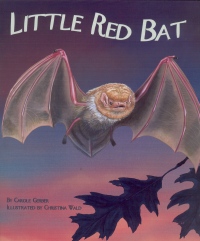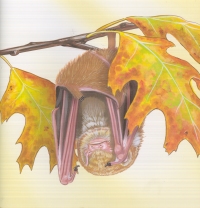| ________________
CM . . . . Volume XVII Number 34 . . . . May 6, 2011
excerpt:
Who knew that a little Red Bat could be endearing? Thanks to award-winning children's science and textbook author Carole Gerber's exquisite account of the common Red Bat's life and the charming illustrations by Christina Wald, young Canadian children will have the opportunity to learn about the much maligned bat. Animals adapt to the changing seasons in a variety of ways to ensure their survival. The Red Bat, we discover, has a choice to make. It can either hibernate over the winter or fly along with migrating birds to warmer southern climes. In Gerber's story, the bat meets up with fellow woodland creatures: deer, squirrel, rabbit, mouse, wild turkey, and chipmunk, all of which have their particular ways of adapting to ensure species survival in the harsh northern winter. They also warn the little bat about many potential dangers she faces: people owls, hawks, foxes, cats and raccoons. In the end, the little bat decides to fly south with a flock of sparrows, hopefully to safety. The story is charming enough; however, the book also contains a "For Creative Minds" educational section which deals with the biology and life cycle of the bat, how animals deal with seasonal changes. On-line teaching resources are also available at: www.SylvanDellPublishing.com. Highly Recommended. Ian Stewart has had a varied career as a Reading Recovery, literacy and math support, kindergarten and grade 2 & 3 teacher at David Livingstone School in Winnipeg, MB. Copyright © the Manitoba Library Association. Reproduction for personal
use is permitted only if this copyright notice is maintained. Any
other reproduction is prohibited without permission.
NEXT REVIEW |
TABLE OF CONTENTS FOR THIS ISSUE
- May 6, 2011.
AUTHORS |
TITLES |
MEDIA REVIEWS |
PROFILES |
BACK ISSUES |
SEARCH |
CMARCHIVE |
HOME |

